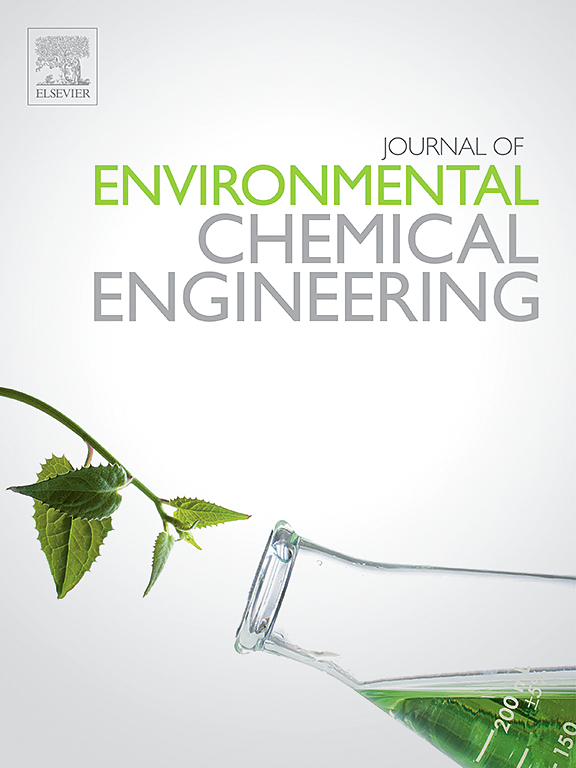电子传递机制介导的 MOF 衍生纳米花催化剂促进过一硫酸盐活化和环丙沙星降解
IF 7.4
2区 工程技术
Q1 ENGINEERING, CHEMICAL
引用次数: 0
摘要
通过对 ZIF-67 前驱体进行锰掺杂和煅烧,合成了三种 MOF 衍生纳米粒子。使用 SEM、TEM、XRD、FTIR 和 BET 分析比较了这些材料的表面理化性质。其中,钴锰氧化物纳米流体(CoMn2O4-NFs)在活化过一硫酸盐(PMS)降解环丙沙星(CIP)的过程中表现出优异的催化性能,30 分钟内的去除率达到 100%,速率常数(kobs)为 0.2960 min-1。通过淬灭实验、EPR、电化学分析和 X 射线光电子能谱(XPS)阐明了催化机理。结果表明,非自由基氧化过程主要由直接电子传递和 1O2 (∼80%)引发,自由基 SO4-- (∼20%)的贡献较小。CoMn2O4-NFs 表面的纳米致密结构使其很容易与 PMS 结合形成 CoMn2O4-NFs/PMS* 复合物,直接从 CIP 中捕获电子完成降解过程。CoMn2O4-NFs 上钴锰离子和氧空位的双重氧化还原循环可加速电子转移过程。CoMn2O4-NFs 在较宽的 pH 值范围(3-11)内都能保持较高的去除率(99%),且受大多数环境阴离子的干扰极小,表现出较强的稳定性和抗干扰性。这项研究为利用金属基材料通过非自由基途径氧化降解有机污染物提供了启示。本文章由计算机程序翻译,如有差异,请以英文原文为准。
Electron transfer mechanism mediated MOF-derived nanoflowers catalyst for promoting peroxymonosulfate activation and ciprofloxacin degradation
Three MOF-derived nanoparticles were synthesized by manganese doping and calcination of ZIF-67 precursor. The surface physicochemical properties of these materials were compared using SEM, TEM, XRD, FTIR and BET analyses. Among them, cobalt-manganese oxide nanoflowers (CoMn2O4-NFs) exhibited excellent catalytic performance in the degradation of ciprofloxacin (CIP) by activated peroxymonosulfate (PMS), achieving 100 % removal within 30 minutes with a rate constant (kobs) of 0.2960 min−1. The catalytic mechanism was elucidated by quenching experiments, EPR, electrochemical analysis and X-ray photoelectron spectroscopy (XPS). The results show that the non-radical oxidation process was initiated mainly by direct electron transfer and 1O2 (∼80 %), with a small contribution from the radical SO4·- (∼20 %). The nano-confined structure on the surface of CoMn2O4-NFs makes it easy to combine with PMS to form CoMn2O4-NFs/PMS* complexes, which directly capture electrons from CIP to complete the degradation process. The double redox cycle of cobalt-manganese ions and oxygen vacancies on CoMn2O4-NFs could accelerate the electron transfer process. CoMn2O4-NFs maintained high removal efficiency (>99 %) over a wide pH range (3−11), with minimal interference from most environmental anions, demonstrating strong stability and interference resistance. This study provides insights into using metal-based materials for oxidative degradation of organic pollutants via non-radical pathways.
求助全文
通过发布文献求助,成功后即可免费获取论文全文。
去求助
来源期刊

Journal of Environmental Chemical Engineering
Environmental Science-Pollution
CiteScore
11.40
自引率
6.50%
发文量
2017
审稿时长
27 days
期刊介绍:
The Journal of Environmental Chemical Engineering (JECE) serves as a platform for the dissemination of original and innovative research focusing on the advancement of environmentally-friendly, sustainable technologies. JECE emphasizes the transition towards a carbon-neutral circular economy and a self-sufficient bio-based economy. Topics covered include soil, water, wastewater, and air decontamination; pollution monitoring, prevention, and control; advanced analytics, sensors, impact and risk assessment methodologies in environmental chemical engineering; resource recovery (water, nutrients, materials, energy); industrial ecology; valorization of waste streams; waste management (including e-waste); climate-water-energy-food nexus; novel materials for environmental, chemical, and energy applications; sustainability and environmental safety; water digitalization, water data science, and machine learning; process integration and intensification; recent developments in green chemistry for synthesis, catalysis, and energy; and original research on contaminants of emerging concern, persistent chemicals, and priority substances, including microplastics, nanoplastics, nanomaterials, micropollutants, antimicrobial resistance genes, and emerging pathogens (viruses, bacteria, parasites) of environmental significance.
 求助内容:
求助内容: 应助结果提醒方式:
应助结果提醒方式:


